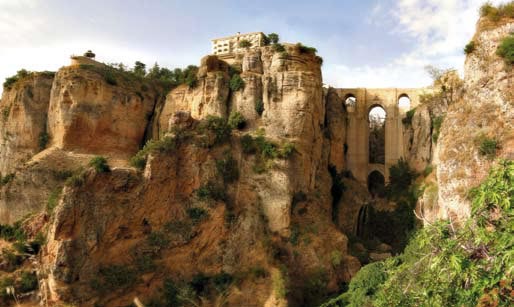It is the universal symbol of the city of Ronda due to its magnitude and beauty. Its construction allowed the natural expansion of Ronda through the flat area of the Mercadillo meadow.
Although the idea of building a bridge in the highest part of the city was already presented in 1542, the project did not begin to be executed until 1735 when a single arch bridge was built, 35 meters in diameter and 100 meters high. in just eight months, and it lasts only six years on its feet, due to a bad closing of the arch and the lack of firmness of the supports.
It is when to counteract this misfortune, the Council, with the mayor D. Francisco Arias Camisón in front, improves the accesses of the city through the Santa Cecilia Bridge, breaking the wall and building a zigzag ramp and the Arch of Felipe V. Although This solution did not satisfy anyone, since the slope was so steep that it impeded the transit of carriages, so that the idea of the bridge had to be recovered from the highest and flattest part.
The works were resumed in 1759. The Council of Ronda requests a license from the Council of Castile, in order to undertake the works and finance them with its own funds and the 3% tax on the transactions carried out at the May Fair.
Although the resources were not sufficient, the work began with the construction of the lateral buttresses, under the direction of the city’s builders Pedro Reguera, Jerónimo Ruiz and Alonso Gil.
In 1778, a plan drawn up by D. Domingo Loys was presented, in which the amount necessary to complete the work was reflected, to which should be added the essential construction of a parapet or curtain, after the recognition made by the Council of Castile for the War Commissioner Don Marcos Vierna and the architect of the Cathedral of Jaén, D. Manuel Godoy.
Already in 1785, a “Memorial” was sent to the King by the Ronda Council, informing him that two-thirds of the works had been completed and the need for its completion. Plans were sent for it and the proposal to be directed by D. Domingo Loys, who seems to have been the one who closed the lower arch. On July 29 of that same year, Don Diego de Córdoba, in charge of the roads of Malaga, is urged by the Council of Castile to recognize the condition of the bridge and its cost until completion. On October 28, once the works and their “Memorial” had been inspected, he recommended to the Council that it appoint Don Diego de Cañas (Knight of the Order of Santiago and Lieutenant of Hermano Mayor de la Real Maestranza de Caballería) and architect to José Martín de Aldehuela. The expenditure forecast was maintained at 1,200,000 reais, two-thirds of which would be contributed by Ronda and the remaining third by 32 towns of the Malaga City Council and 8 from Seville.
These two people were decisive in the completion of the Bridge. The financial problems derived from the opposition of the mayor the Marqués de Pejas and the group that supported him had to be overcome, as well as the refusal of Marbella, Jimena, Ubrique and Zahara to contribute to a work that they understood did not bring them any benefit. Cañas was able to count on the excellent collaboration of the treasurer Juan Ramos de Oviedo, who even advanced him from his own pocket the amount of 56,000 reais and another contribution from the Real Maestranza of 15,000 reais.
José Martín de Aldehuela, author of the Aqueduct of San Telmo and the Church of San Felipe in Malaga, was the one who drew up the plans and directed the construction of the main arch and the upper road for the completion of the bridge. Due to his poor health, he was replaced in the direction of the works on several occasions by the builder Juan de Lara and the stonemason Pedro Martín. Excellent was the collaboration of Juan A. Díaz Machuca from Ronda, who built various mills that greatly facilitated the contribution of materials in such a complicated and dangerous work.
On November 4, 1787, the bridge was opened for the first time for the passage of cavalry, carriages and people. Don Diego de Cañas being distinguished by the King with the key of Gentile-Man of the Royal Chamber.
New bridge

Comments are closed.
